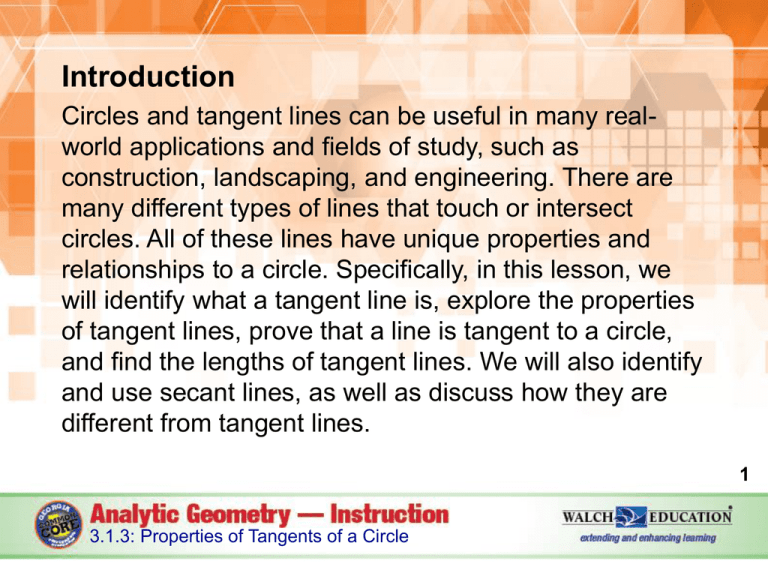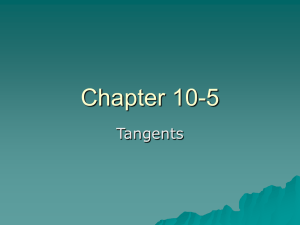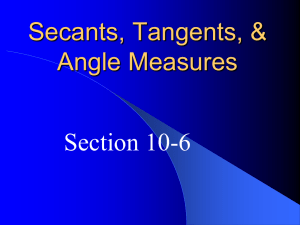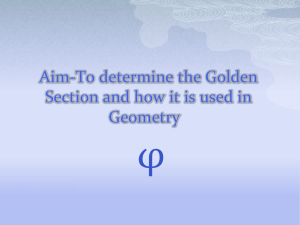3.1.3
advertisement

Introduction Circles and tangent lines can be useful in many realworld applications and fields of study, such as construction, landscaping, and engineering. There are many different types of lines that touch or intersect circles. All of these lines have unique properties and relationships to a circle. Specifically, in this lesson, we will identify what a tangent line is, explore the properties of tangent lines, prove that a line is tangent to a circle, and find the lengths of tangent lines. We will also identify and use secant lines, as well as discuss how they are different from tangent lines. 1 3.1.3: Properties of Tangents of a Circle Key Concepts • A tangent line is a line that intersects a circle at exactly one point. • Tangent lines are perpendicular to the radius of the circle at the point of tangency. 2 3.1.3: Properties of Tangents of a Circle Key Concepts, continued • You can verify that a line is tangent to a circle by constructing a right triangle using the radius, and verifying that it is a right triangle by using the Pythagorean Theorem. • The slopes of a line and a radius drawn to the possible point of tangency must be negative reciprocals in order for the line to be a tangent. • If two segments are tangent to the same circle, and originate from the same exterior point, then the segments are congruent. 3 3.1.3: Properties of Tangents of a Circle Key Concepts, continued • The angle formed by two tangent lines whose vertex is outside of the circle is called the circumscribed angle. • ∠BAC in the diagram is a circumscribed angle. • The angle formed by two tangents is equal to one half the positive difference of the angle’s intercepted arcs. tangent AB = tangent AC 4 3.1.3: Properties of Tangents of a Circle Key Concepts, continued • A secant line is any line, ray, or segment that intersects a circle at two points. 5 3.1.3: Properties of Tangents of a Circle Key Concepts, continued • An angle formed by a secant and a tangent is equal to the positive difference of its intercepted arcs. 6 3.1.3: Properties of Tangents of a Circle Common Errors/Misconceptions • assuming that a radius and a line form right angles at the possible point of tangency simply by relying on observation • assuming that two tangent lines are congruent by observation • making incorrect calculations (usually sign errors) when using the slope formula • making incorrect calculations when using formulas such as the Pythagorean Theorem and the distance formula • confusing secant lines and tangent lines 7 3.1.3: Properties of Tangents of a Circle Guided Practice Example 2 Each side of is tangent to circle O at the points D, E, and F. Find the perimeter of . 8 3.1.3: Properties of Tangents of a Circle Guided Practice: Example 2, continued 1. Identify the lengths of each side of the triangle. AD is tangent to the same circle as AF and extends from the same point; therefore, the lengths are equal. AD = 7 units 9 3.1.3: Properties of Tangents of a Circle Guided Practice: Example 2, continued BE is tangent to the same circle as BD and extends from the same point; therefore, the lengths are equal. BE = 5 units To determine the length of CE , subtract the length of BE from the length of BC. 16 – 5 = 11 CE = 11 units 10 3.1.3: Properties of Tangents of a Circle Guided Practice: Example 2, continued CF is tangent to the same circle as CE and extends from the same point; therefore, the lengths are equal. CF = 11 units 11 3.1.3: Properties of Tangents of a Circle Guided Practice: Example 2, continued 2. Calculate the perimeter of Add the lengths of AD, AF, BD, BE, CE, and CF to find the perimeter of the polygon. 7 + 7 + 5 + 5 + 11 + 11 = 46 units The perimeter of is 46 units. ✔ 12 3.1.3: Properties of Tangents of a Circle Guided Practice: Example 2, continued 13 3.1.3: Properties of Tangents of a Circle Guided Practice Example 4 at point AB is tangent to B as shown at right. Find the length of AB as well as 14 3.1.3: Properties of Tangents of a Circle Guided Practice: Example 4, continued 1. Find the length of AB . Since AB is tangent to , then ∠ABC is right angle because a tangent and a radius form a right angle at the point of tangency. Since ∠ABC is a right angle, is a right triangle. Use the Pythagorean Theorem to find the length of AB. 15 3.1.3: Properties of Tangents of a Circle Guided Practice: Example 4, continued a2 + b2 = c2 82 + (AB)2 = 172 64 + (AB)2 = 289 Pythagorean Theorem Substitute values for a, b, and c. Simplify. (AB)2 = 225 AB = 15 The length of AB is 15 units. 16 3.1.3: Properties of Tangents of a Circle Guided Practice: Example 4, continued 2. Find . First, determine the unknown measure of ∠ACB. Recall that the sum of all three angles of a triangle is 180°. ∠ABC is a right angle, so it is 90°. ∠BAC is 28°, as shown in the diagram. Set up an equation to determine the measure of ∠ACB. 17 3.1.3: Properties of Tangents of a Circle Guided Practice: Example 4, continued 28 + 90 + m∠ACB = 180 118 + m∠ACB = 180 m∠ACB = 62 Since m∠ACB = 62, then m∠BCD = 118 because ∠ACB and ∠BCD are a linear pair. ∠BCD is a central angle, and recall that the measure of a central angle is the same as its intercepted arc, so is 118°. ✔ 18 3.1.3: Properties of Tangents of a Circle Guided Practice: Example 4, continued 19 3.1.3: Properties of Tangents of a Circle








